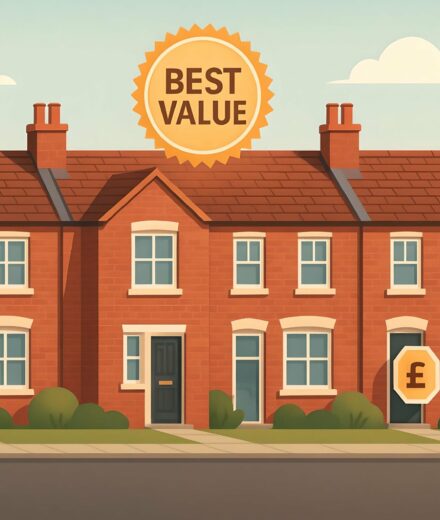

House Prices > Plymouth
| Year | Average Price | Transactions |
|---|---|---|
| 2025 (proj.) | £249,100 | 4,796 |
| 2024 | £242,100 | 3,757 |
| 2023 | £241,900 | 4,211 |
| 2022 | £239,800 | 5,257 |
| 2021 | £227,800 | 5,727 |
| 2020 | £218,500 | 4,302 |
| 2019 | £209,100 | 5,132 |
| 2018 | £204,400 | 5,186 |
Look past the glossy headlines about Plymouth’s property surge and you’ll spot a city with housing prices inching upwards, persistently, stubbornly, begrudgingly — but with a tempo that feels less feverish and more weary. The average home price has climbed each year, but if you scratch beneath that surface, the picture feels less like a “booming coastal market” and more like a nervy game of brinkmanship.
For most, Plymouth is seen as the South West’s safe bet. But buying in this market right now feels a bit like grabbing a deckchair on the Titanic — timing is everything and complacency may just be expensive.
For those who prefer to dig deeper rather than float with the tide, take a look at Understanding House Prices in Plymouth: What’s Your Property Value? for the figures mainstream coverage leaves out.
So, what should we remember? Plymouth’s price rises look tempting but, for the sharp-eyed, the shrinking pool of transactions gives off a distinct whiff of caution. Don’t mistake steady price gains for guaranteed stability — in this city, the tide can turn quickly… and unpredictably.
Wondering if now’s a good time to buy in Plymouth? See for yourself with our current houses for sale in Plymouth.

Avg. Property Price: £392,200
Avg. Size of Property
1,282 sq/ft
Avg. Cost Per Sq/ft
£323 sq/ft
Total transactions
1,471 (since 2021)

Avg. Property Price: £252,000
Avg. Size of Property
968 sq/ft
Avg. Cost Per Sq/ft
£268 sq/ft
Total transactions
3,741 (since 2021)

Avg. Property Price: £199,800
Avg. Size of Property
971 sq/ft
Avg. Cost Per Sq/ft
£217 sq/ft
Total transactions
7,502 (since 2021)

Avg. Property Price: £155,500
Avg. Size of Property
661 sq/ft
Avg. Cost Per Sq/ft
£232 sq/ft
Total transactions
995 (since 2021)
There’s a kind of quiet ache in Plymouth’s property story, where the expectation of space battles the practicalities of modern budgets. Detached homes remain an aspirational anchor in the city’s property line-up: roomy, scarce, and priced in a way that feels almost as distant as the shipyards at dawn. For families longing for more space, that near-mythic sense of possibility comes at a tangible price, partly balanced by their generous square footage and a cost per square foot that, while high, still trails larger southern cities.
By contrast, flats capture a different Plymouth mood. Compact, urban, and for many, the only realistic route to stepping on the ladder at all. At M0VE, we’ve seen younger buyers and downsizers quietly favour these, drawn by the lower entry price and the central, bustling neighbourhoods. But there’s a bittersweet note – gone are the days when a first flat promised a quick leap to a house with a garden. Now, the cost per square foot leaves little room for the dreamy optimism of decades past.
Semi-detached and terraced properties form the city’s backbone. Plymouth has always felt a bit more grounded than glitzy. These homes hold their appeal, not just for first-timers but for families seeking a certain rhythm – parks nearby, schools in walking distance, and neighbours you might actually greet. What’s striking is the bustling activity: high transaction numbers that hint at persistent demand, matched by a mid-range cost per square foot that feels quietly reasonable. Buying a home here is no longer a sprint – it’s a strategic game of chess in the city's crowded market, where patience and timing matter more than ever.
We often hear from clients hoping to move from terraced to semi-detached homes, attracted by just a smidge more space and a morsel of garden – reminding us that in Plymouth, even the smallest move upward is a victory worth celebrating.
For those thinking carefully about Plymouth’s future and their place within it, it’s worth exploring how values ebb and flow across the city’s patchwork of postcodes. For a deeper dive into signals shaping prices each year, see our guide: Plymouth House Price Trends: Know What Your Home’s Worth.
| District | Avg Price (£) | Transactions |
|---|---|---|
| PL1 | £203,300 | 3,750 |
| PL2 | £175,300 | 4,009 |
| PL3 | £241,100 | 3,797 |
| PL4 | £185,200 | 4,336 |
| PL5 | £178,700 | 4,092 |
| PL6 | £243,200 | 4,509 |
| PL7 | £245,900 | 3,866 |
| PL8 | £432,300 | 729 |
| PL9 | £285,100 | 4,793 |
Plymouth’s property scene this year is blazing with activity, with each district revealing a different story in both price and pace. The variety is remarkable – neighbourhoods just a quick bus ride apart come with strikingly different price tags and energy. The competition for homes has been heating up faster than a barbecue on the Hoe during a rare sunny spell and buyers are feeling the excitement – and pressure.
Affordable hotspots like PL2, PL4, and PL5 keep Plymouth’s dream of homeownership alive for first-time buyers, young families, and those seeking value for money. These districts reflect the city’s refreshingly accessible side, where finding a home under the psychological £200,000 mark is downright achievable. *It feels as lively as Mutley Plain on a Saturday – bustling, diverse and brimming with possibility*.
In stark contrast, PL8 and PL9 stand out as the city’s superstar postcodes. Here, prices stretch higher, reflecting both the peaceful, picturesque settings and larger, grander homes that attract those aiming for a slice of Plymouth’s very best. The tendency for fewer property transactions in these premium areas points to exclusivity – and perhaps the reluctance of contented residents to let go of these fantastic spots.
PL6 and PL7 offer a compelling middle ground – energetic, convenient, and just far enough from the city centre to enjoy extra space, yet still within reach of Plymouth’s schools, shopping, and coast. These districts buzz with steady movement, making them a magnet for growing families and upgraders.
What’s fascinating is the consistently high volume of transactions in districts like PL4, PL5, and PL2. These neighbourhoods show off Plymouth’s incredibly dynamic, accessible property market. The race isn’t just for the highest price – it’s about finding the right fit for your lifestyle and ambitions.
It’s clear: your choice of district shapes both your budget and your experience in Plymouth’s electric housing market. Those in the know are choosing areas that not only fit their pocket but align with their ambitions. Looking for pinpointed tips on timing your move? Check out our guide Plymouth Property Turnaround: How Fast Are Homes Selling? for sharper, streetwise advice.
Please also check out the following areas in Plymouth for further insights:
| City | Avg Price (£) | Transactions |
|---|---|---|
| Torpoint | £260,100 | 1,198 |
| Saltash | £254,400 | 1,741 |
| Yelverton | £331,700 | 703 |
| Ivybridge | £293,000 | 2,055 |
| Tavistock | £310,200 | 1,868 |
| Callington | £261,400 | 962 |
| Looe | £291,200 | 1,054 |
| Liskeard | £234,500 | 2,253 |
| Kingsbridge | £387,900 | 1,567 |
| Totnes | £391,400 | 1,648 |
Plymouth’s property market never sits still for long. Some streets in the city have become hotter property than a last-minute Glastonbury ticket. But, if we step back and take a sceptical look at how house prices here compare with nearby towns, a far more colourful story starts to unfold. You can almost feel the tug of the Cornish border, with values shifting as quickly as the breeze off the Hoe.
What strikes us right away? The diversity in average prices on Plymouth’s doorstep is nothing short of remarkable. A handful of smaller neighbouring towns, like Kingsbridge and Totnes, command prices nudging towards or even surpassing the £390,000 mark. It’s a steep ask, especially for first-time buyers or families looking to upgrade. In towns like these, you’re often paying for that slice of postcard countryside, peaceful lanes, or a getaway-to-the-sea feeling that daily life in Plymouth doesn’t always deliver.
Then again, the rural premium is very real. If you’re eyeing up a characterful cottage in a scenic Dartmoor village, be prepared for a price tag that’s steeper than the hills above Yelverton. The allure of countryside schools, fresh air, and that “Friday night at the pub” charm doesn’t seem to be fading.
At M0VE, we’ve noticed that many buyers flirt with the idea of moving one or two stops down the line—and for good reason. You can get more house for your money in Liskeard or Saltash, with less competition than in the more headline-grabbing towns. The trade-off? Maybe a longer commute or a less buzzy Saturday morning.
So what’s the core message? Plymouth and its neighbours bring a wildly varied mix of property price, pace, and character. Choose where your priorities lie, and you’ll find more than one sweet spot—if you look beyond the obvious.
Please remember, the data compares broad pricing averages and sales volume only.
No adjustments have been made for home sizes or per square foot value. For deeper insights, head over to our blog. Thanks for reading.
Instead of offering quick guesses, we produce carefully adapted numbers that hold up across postcode lines and property types.
Our site uses cookies. By using this site, you agree to the Privacy Policy and Terms of Use.